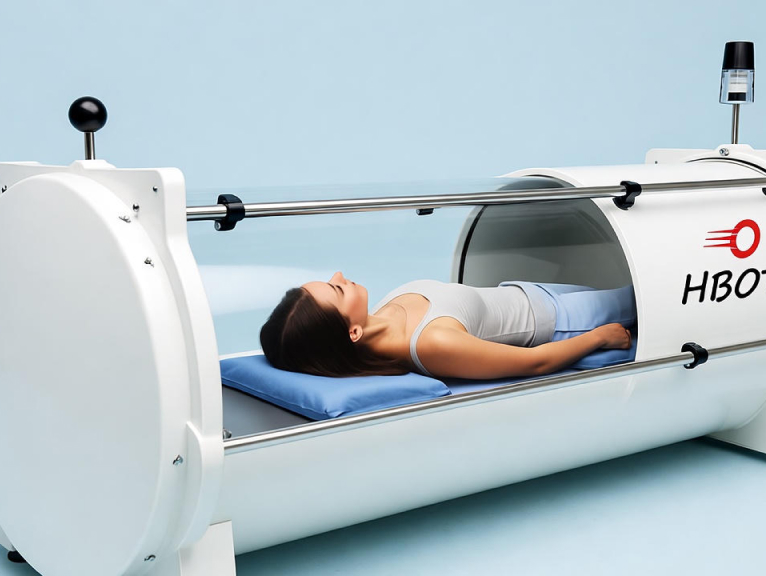
20 Years of Producing the Highest Quality, Most Reliable, and Effective LED mask.
Discover how hyperbaric oxygen therapy (HBOT) promotes healing using pressurized chambers. Explore benefits, risks, preparation, process, and how combining HBOT with red light therapy enhances recovery, reduces inflammation, and optimizes health outcomes in this comprehensive guide.

Hyperbaric oxygen therapy (HBOT) is a medical treatment that involves breathing pure oxygen in a pressurized environment, enhancing the body's natural healing processes. As wellness trends evolve in 2025, HBOT is gaining popularity not only for traditional medical applications but also in combination with complementary therapies like red light therapy (RLT). This synergy offers enhanced benefits for recovery, inflammation reduction, and overall health optimization. This guide explores HBOT's mechanisms, benefits, risks, preparation, process, and post-treatment care, while incorporating insights on its powerful combination with RLT. Whether you're recovering from injury or seeking performance enhancement, understanding these therapies can revolutionize your approach to health.
Hyperbaric oxygen therapy involves breathing pure oxygen in a pressurized environment. It is a well-established treatment for decompression sickness, a hazard of scuba diving. Other conditions treated include serious infections, arterial gas embolism, and wounds that may not heal because of diabetes or radiation injury.
Inside the chamber, air pressure is raised to about two–three times normal. Under these conditions, your lungs can take in much more oxygen than when breathing pure oxygen at regular pressure.
When your blood carries this extra oxygen, it helps fight bacteria and can stimulate the release of growth factors and stem cells that promote healing.
Body tissues need adequate oxygen to function, and injured tissue needs even more. Repeated treatments temporarily raise tissue oxygen levels, which may encourage normal levels after therapy ends.
HBOT works by increasing oxygen dissolution into the bloodstream, allowing it to reach oxygen-deprived areas. This promotes healing, reduces inflammation, reduces swelling, enhances tissue repair, and supports natural healing processes. At the cellular level, the oxygen-rich environment is essential for cell survival and repair, stimulating mitochondria to produce more energy and enabling cells to function efficiently.
Hyperbaric oxygen therapy is used for several conditions. Your doctor may suggest it if you have:
Hyperbaric oxygen therapy is generally safe, and complications are rare. Possible risks include:
You will change into a hospital-approved gown or scrubs. Lighters, battery-powered heat sources, and petroleum-based skin or hair products must be removed to reduce fire risk. Your care team will give specific instructions.
Treatment is usually outpatient but may be done while hospitalized. Two main chamber types are used:
Whether you are in an individual or multi-person setting, the potential benefits of hyperbaric oxygen therapy are the same.
During therapy, the room’s air pressure is about two to three times normal atmospheric pressure. The increase may create a temporary feeling of fullness in your ears, similar to what you might experience in an airplane or at high altitude. Yawning or swallowing can help relieve this sensation.
For most conditions, a session lasts about two hours. Your care team will monitor you and the chamber throughout treatment.
Your team will assess you—checking your ears, blood pressure, and pulse. If you have diabetes, they will also measure your blood glucose. Once cleared, you can dress and leave.
You may feel slightly tired or hungry afterward; normal activities are not restricted.
Combining HBOT with red light therapy (RLT) creates a powerful synergy for enhanced healing. RLT uses wavelengths of 630-880 nm to penetrate skin and tissues, stimulating mitochondria to produce more energy, reduce pain, improve skin texture, and aid conditions like joint pain and muscle aches. HBOT's oxygen saturation complements RLT's cellular energy boost, creating an optimal environment for repair. Together, they accelerate recovery, reduce inflammation more effectively, and support tissue regeneration, with patients reporting faster healing and improved quality of life.
The combination offers amplified advantages:
In 2025, HBOT and RLT are used in wellness centers for surgery recovery, sports performance, and chronic conditions. Case studies show athletes recovering 40% faster from injuries. Emerging integrations include AI-monitored sessions for personalized dosing.
Consult your doctor. Use home RLT devices post-HBOT sessions. Sessions: HBOT 1-2 hours, 3-5x/week; RLT 10-20 min daily. Track progress; combine with nutrition for synergy. Costs: HBOT $200-500/session, RLT devices $100-300.
Offer combined protocols for enhanced outcomes. Training: $1,000-2,000; charge $300-600/session. Market as revolutionary biohacking; ROI from repeat clients.
HBOT risks include ear injuries, oxygen toxicity; RLT is safer but avoid overuse. Consult for conditions like diabetes or claustrophobia. Use certified chambers and devices.
Multiple sessions are usually needed. The exact number depends on your condition: carbon-monoxide poisoning may improve in about three visits, whereas non-healing wounds can require 40 or more. Hyperbaric oxygen therapy is typically one component of a broader treatment plan tailored to your needs. Combining with RLT revolutionizes recovery—explore LedMask.co for options.
